Brent Geese are an endearing staple of the winter birding scene on many estuaries, chiefly on the east and south coasts of England and around the coast of Ireland. All four of the world’s Brent forms have been recorded in Britain and Ireland, but the temptation is to assume that all birds in a grazing flock are the same. Given that stray individuals or family groups of one form may still wander and turn up within flocks of another, however, that assumption would be a mistake. Andy Stoddart highlights ID tips to separate Dark-bellied and Pale-bellied Brents, Black Brant and ‘Grey-bellied’ Brant.
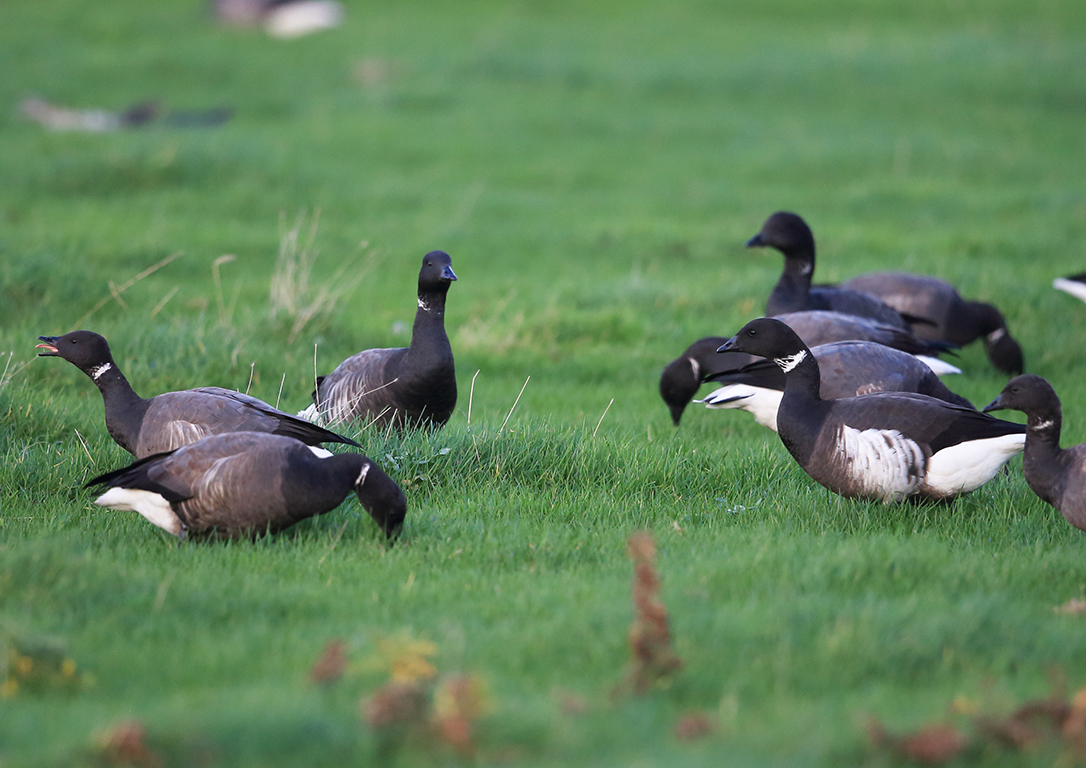
Black Brant (front, right) with Dark-bellied Brent Geese (Cley Marshes NWT, Norfolk, 16 November 2015). This group of Dark-bellied Brent Geese presents the usual kaleidoscope of black, white and grey plumage hues. Although changes in angle and light constantly reinvent the plumage of Brent Geese, there is another subspecies present here: an adult Black Brant standing out by virtue of its bright white flank patch, its deep and very bold white neck collar and, perhaps most importantly of all, by the strongly dark earth-brown or mahogany hues to the underparts and upperparts (Robin Chittenden, www.robinchittenden.co.uk).
Important numbers of both Dark-bellied and Pale-bellied Brent Geese winter, Black Brant turns up annually in small numbers and the enigmatic ‘Grey-bellied Brant’ has been recorded in Ireland. Despite their current official treatment as subspecies, the differences between the different forms of Brent Goose are greater than between many full species and amount to much more than whether they have a dark or a pale belly. Unfortunately, their treatment in field guides, both in text and illustrations, is often cursory.
Dark-bellied Brent Goose
There is a single population of Dark-bellied Brent Goose, breeding on the northernmost tundra of central Siberia, migrating through the Baltic and wintering mainly around the southern North Sea and in north-west France. In Britain, it winters largely between the estuaries of the Humber and the Exe.
The belly of an adult Dark-bellied Brent Goose is a smoky grey-brown, with paler upper and rear flanks caused by greyish-white feather-tipping. However, some birds can look surprisingly pale below, particularly if aligned differently to the remainder of the flock or lit by strong sunlight. Dark-bellied Brents are at their palest in spring (when they are most worn) and it is at this time of year that the risk of misidentification is greatest.
In all forms of Brent Goose, identification is always best resolved by reference to specific areas of plumage contrast rather than a more subjective assessment of colour hues. The belly of Dark-bellied Brent shows only a moderate contrast with the black breast, and little contrast with the upperparts. The dark belly also extends back between the legs as a rear-pointing triangle of dark feathering, most easily seen from behind. This means that, in flight, an adult Dark-bellied Brent always shows the strongest underpart contrast towards the rear of the bird, between the dark rear belly and the white undertail coverts. It is, however, not only the underparts which repay study. Just as important are the upperparts, which on Dark-bellied Brent are a cold ashy or steely grey-brown.
Pale-bellied Brent Goose
Pale-bellied Brent Geese comprise three populations, two of which reach Britain. One of these breeds on Spitsbergen and Franz Josef Land and winters in Denmark and Northumberland. The other population breeds in northern Greenland and north-east Canada, migrates through Iceland and winters mainly in Ireland and westernmost Britain. The third population breeds in central Arctic Canada and winters on the American Atlantic coast. Out-of-range records in south-east England probably originate from the Spitsbergen population, though individuals accompanying other geese from the north-west (such as Pink-footed Geese) are perhaps more likely to be from Greenland or Canada.
Compared with Dark-bellied, a Pale-bellied Brent Goose can appear perhaps a little shorter-necked with a shorter, more ‘barrel-shaped’ body. Such differences are, however, subtle and firm identification rests entirely on plumage.
Adult Pale-bellied Brents have genuinely very pale bellies and flanks. On many, these areas are a bright chalky-white but on others they are washed with a pale muddy-brown, usually most extensive on the fore-belly. The belly therefore contrasts markedly with the black breast and the upperparts. The area between the legs is entirely white so that on a flying bird the eye-catching contrast is always towards the front of the bird, between the black breast and the whitish belly. The upperparts of Pale-bellied Brents always show distinct mid-brown hues, never grey, so that in mixed groups it can sometimes be easiest to pick out a Pale-bellied Brent by its upperparts colour. Hybrids with Dark-bellied Brents are documented but rare.
Black Brant
Black Brant breeds in Arctic Canada, Alaska and east Siberia. Siberian birds are annual winter visitors to south-east England with Dark-bellied Brents, whereas Canadian birds reach Ireland with Pale-bellied Brents.
Though similar in size and structure to the other forms of Brent Goose, some (perhaps particularly males) often appear rather stocky with large, rather angular heads.
Adult Black Brants show very strong black-and-white plumage contrasts, best appreciated in dull light. The white neck collar is strong and deep, and the upper and rear flanks are strikingly bright white, albeit with some grey vertical lining. The belly is very dark earth-brown, looking black in dull light, and contrasts little with the black breast and the upperparts. The area between the legs is dark, as in Dark-bellied Brent, so that in flight, in flocks of the latter, Black Brants are hard to pick out. The upperparts are dark earth-brown with no grey hues.
Hybrids with Dark-bellied Brents are rare but regular, with some known individuals returning to traditional winter sites and bringing second-generation hybrids. Hybrids resemble Black Brants but show tell-tale subtle grey hues throughout, with a grey wash to the white flanks and grey hues in the upperparts. Their appearance varies tremendously with the light, however, sometimes looking very Brant-like, but at other times being much less striking.
‘Grey-bellied Brant’
A fourth Brent Goose population, breeding mainly on Melville and Prince Patrick Islands in western high-Arctic Canada, has also been recognised, though its taxonomic status remains uncertain and it has no scientific name. It is generally known colloquially as ‘Grey-bellied Brant’. Its appearance is variable, combining features of both Pale-bellied Brent and Black Brant, leading to speculation that it might be an intergrade form, but it has been proposed as a valid subspecies on the basis of DNA analysis as well as morphology.
Grey-bellied Brant is not on the British list but a number of birds apparently of this type have occurred in Ireland and one or two have been suspected in Britain, too. Given that its breeding range abuts that of Canadian Pale-bellied Brents, it is clearly most likely to occur in Ireland and the west.
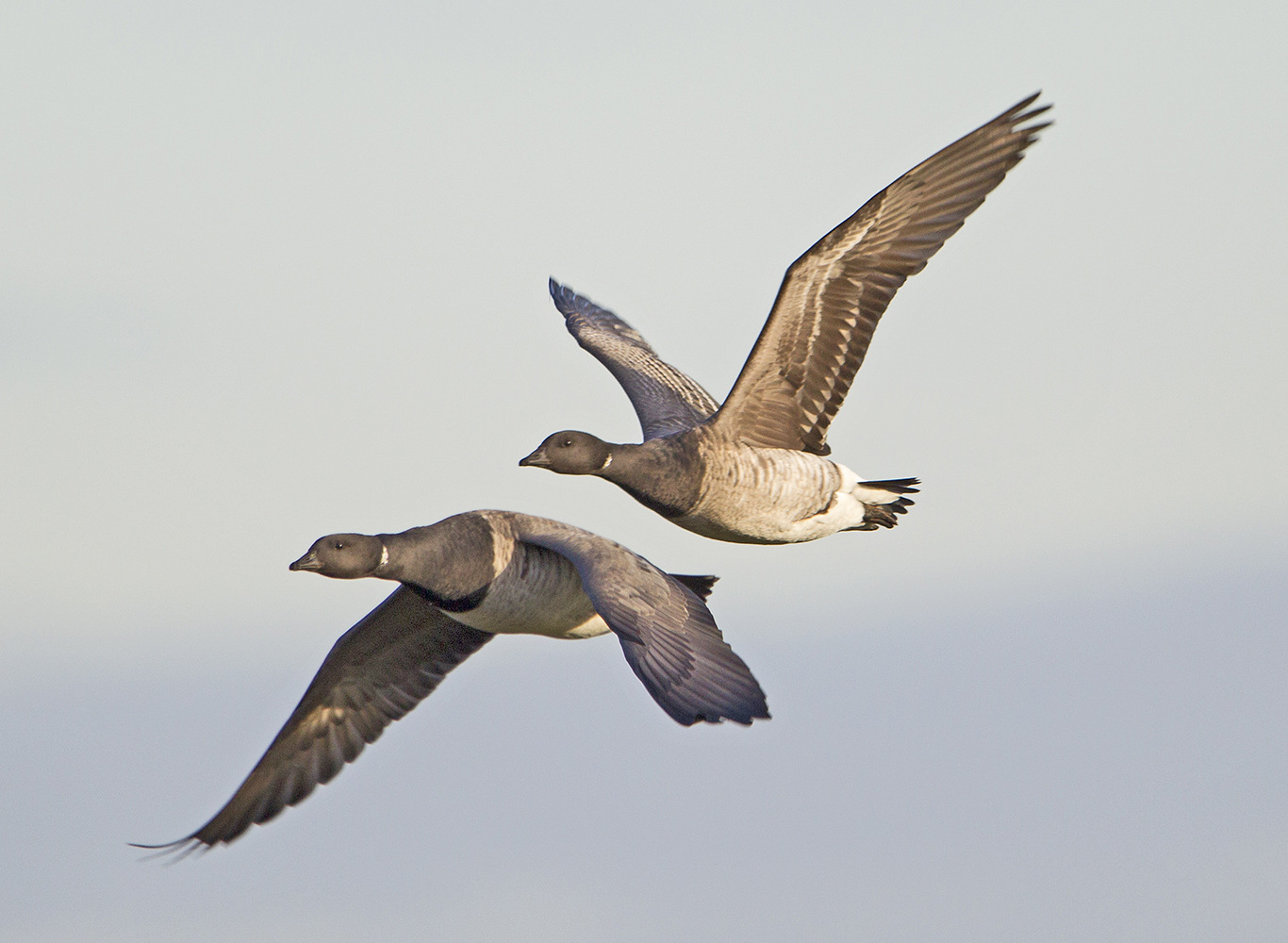
Adult (lower bird) and juvenile Pale-bellied Brent Geese (Donna Nook, Lincolnshire, 6 January 2011). These flying Pale-bellied Brent Geese are identifiable simply by the paleness of their bellies, but assessing precise plumage hues can be difficult. It is always better to focus on the contrast between various parts of the plumage. Here the contrast between black breast and pale belly is very strong and, crucially, the most eye-catching area on the underparts. At the other end of the bird the white central belly merges seamlessly with the white undertail coverts with no contrast visible at all – the key feature of a flying Pale-bellied Brent. Note here also the white tips across the wing coverts which identify the upper bird as a juvenile (Graham Catley).
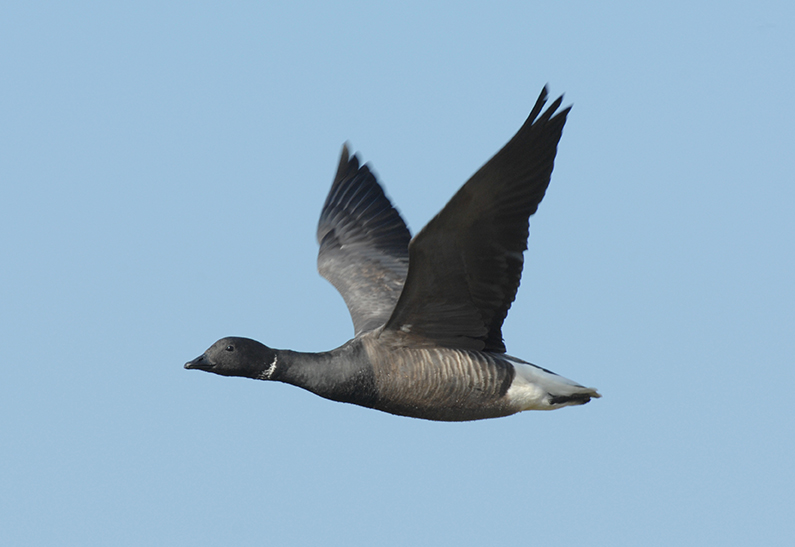
Adult Dark-bellied Brent Goose (Wells-next-the-Sea, Norfolk, 15 March 2007). This flying Dark-bellied Brent Goose provides a good comparison with the above image. Here the contrast between black breast and grey belly is less obvious and, most importantly, there is a strong (and greater) contrast between the dark central belly and the white undertail coverts. The most eye-catching black/white division on the underparts is therefore towards the back of the bird. The well-developed neck collar and entirely plain wing coverts (lacking any white tips) identify this bird as an adult (Richard Brooks, www.richard-brooks.co.uk).
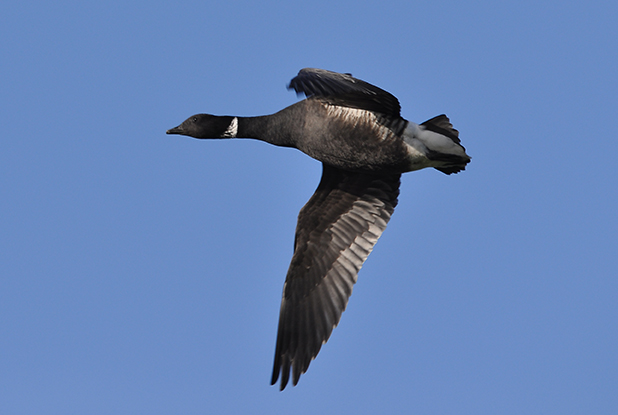
Adult Black Brant (Dungarvan, Co Waterford, 22 November 2009). This flying Black Brant shows an even more striking ‘back end’ contrast, as the very dark belly is almost the same tone as the black breast. The very white flank patch is visible here, too – although partly in shadow – but note how its shape differs from that at rest. On the ground the white rear flanks form a solid almost rectangular patch, whereas in flight the patch appears more elongated, projecting well forward along the upper flanks and almost reaching the leading edge of the wing. The very deep and bold white neck collar is also visible here (Ronan McLaughlin).
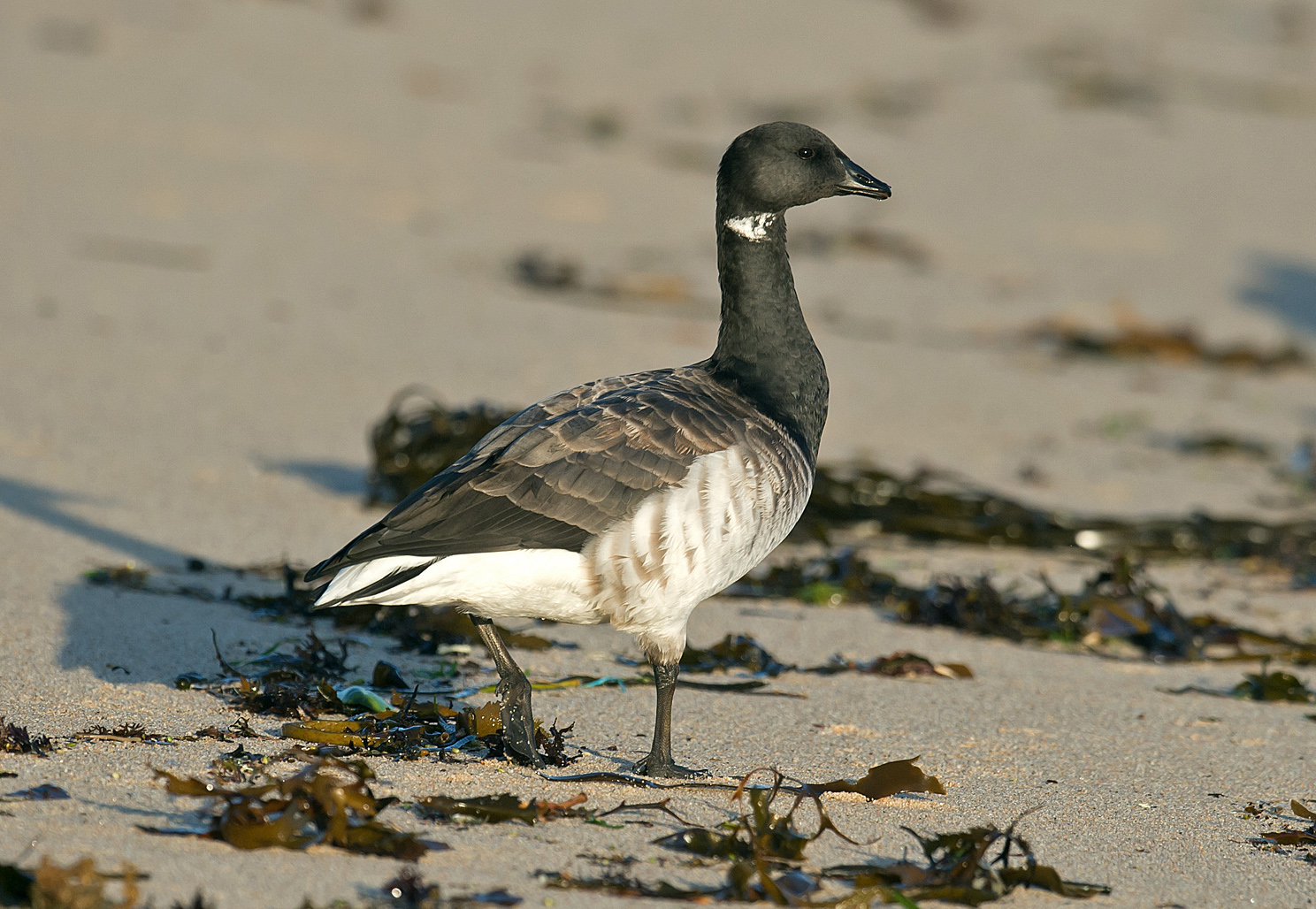
Adult Pale-bellied Brent Goose (St Mary’s, Scilly, 18 October 2012). With its bright chalky-white underparts, striking belly/breast contrast and extensive bright white area between the legs, this is a straightforward Pale-bellied Brent Goose. Note also the relatively weak neck collar and, more importantly, the obvious brown hues in the upperparts, something never shown by Dark-bellied Brent Goose. Although a very subtle character indeed, the bird also appears a little short-bodied (Steve Young, www.birdsonfilm.com).
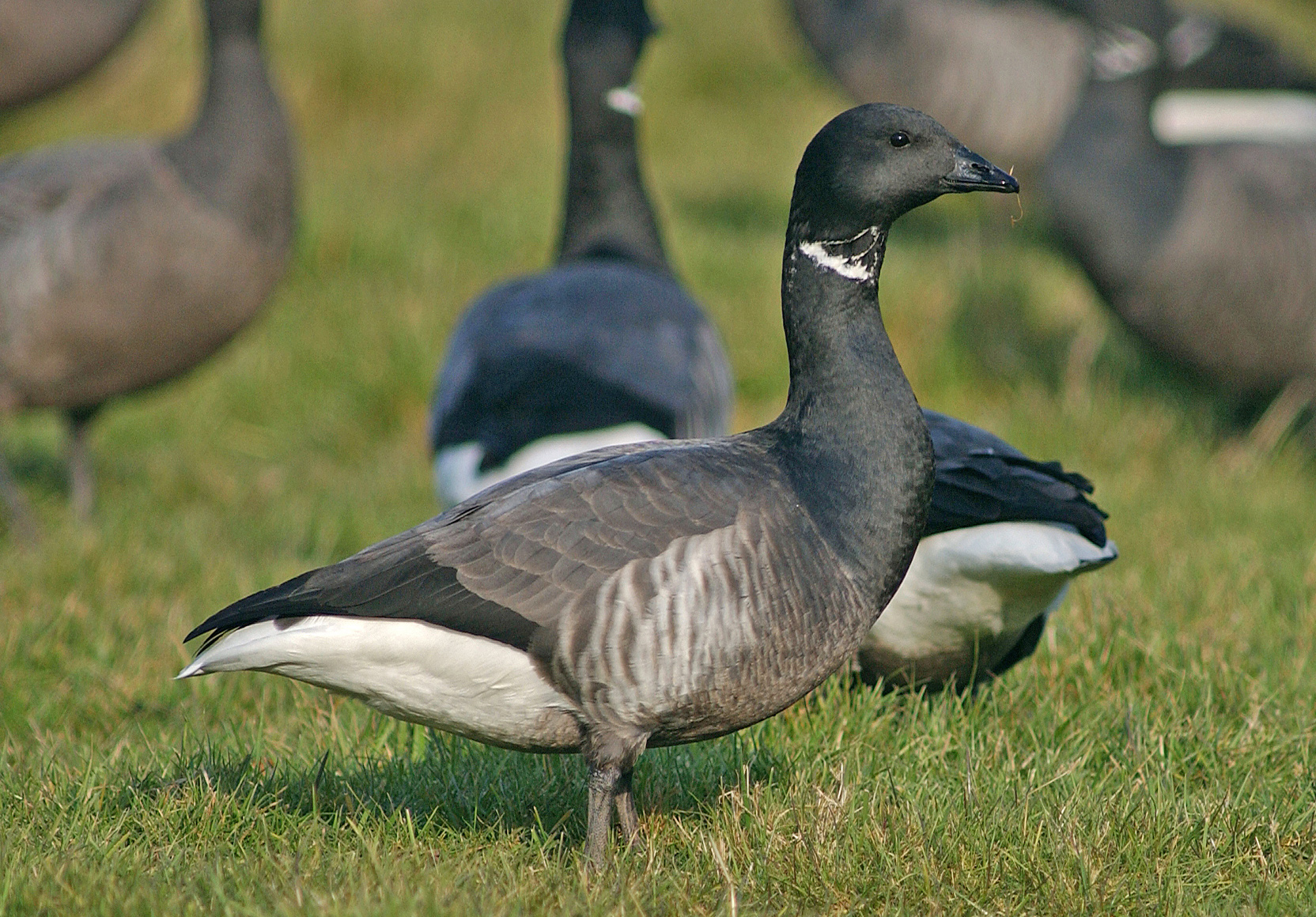
Adult Dark-bellied Brent Goose (Morston, Norfolk, 27 February 2003). With its dull grey belly, weak belly/breast contrast and strong belly/undertail coverts contrast, this is a typical Dark-bellied Brent Goose. The neck collar is typically moderately prominent but the most important feature is the obvious grey ‘glaze’ over the plumage, particularly the upperparts. Such ‘battleship grey’ hues are typical, indeed diagnostic, of Dark-bellied Brent Goose. Finally, note the very fractionally longer body profile than the above Pale-bellied Brent (Steve Young, www.birdsonfilm.com).
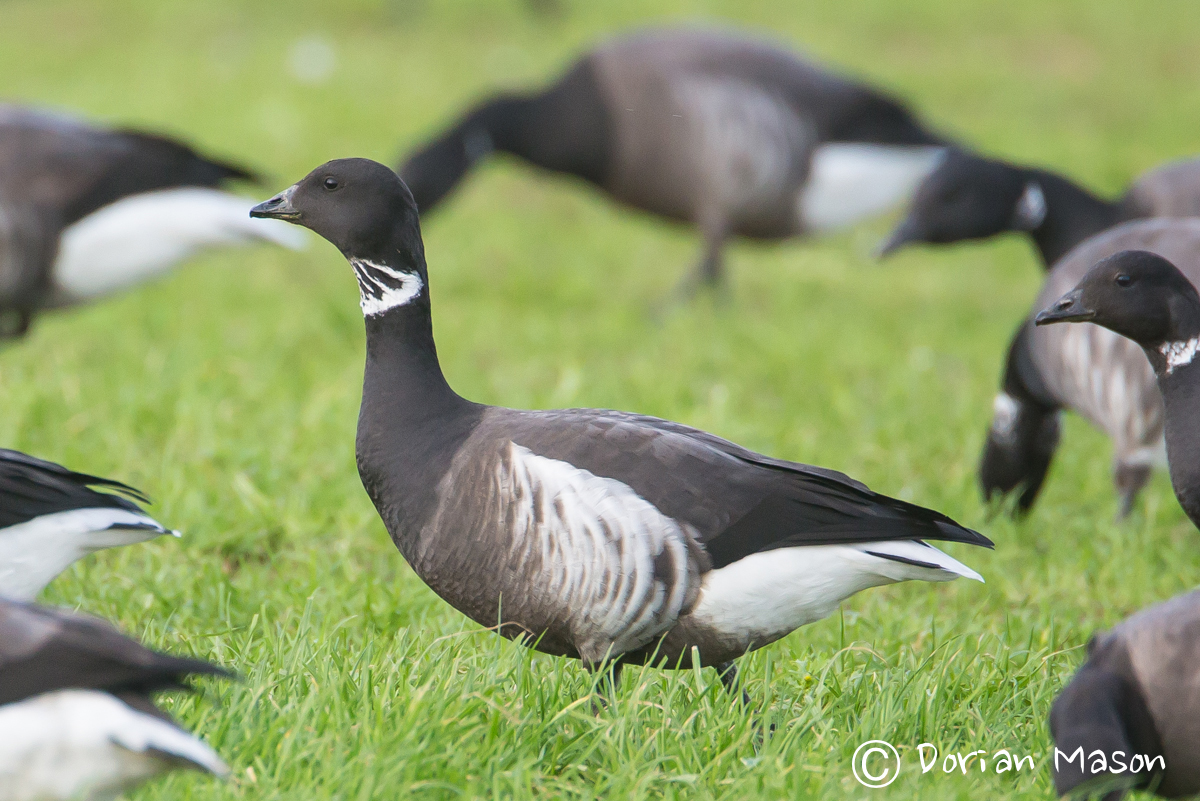
Adult Black Brant (Chichester Harbour, West Sussex, 10 December 2015). With its bold black-and-white contrasts, this Black Brant is a striking bird indeed. The belly/breast contrast is very weak, the belly/undertail coverts contrast is very strong and the white flank patch is extensive and bright (albeit inlaid with some dark vertical lining). The most important feature, however, is the rich deep brown coloration in the belly and the upperparts – a feature never shown by Dark-bellied Brent Goose. Note also the typically bold and deep neck collar (Dorian Mason).
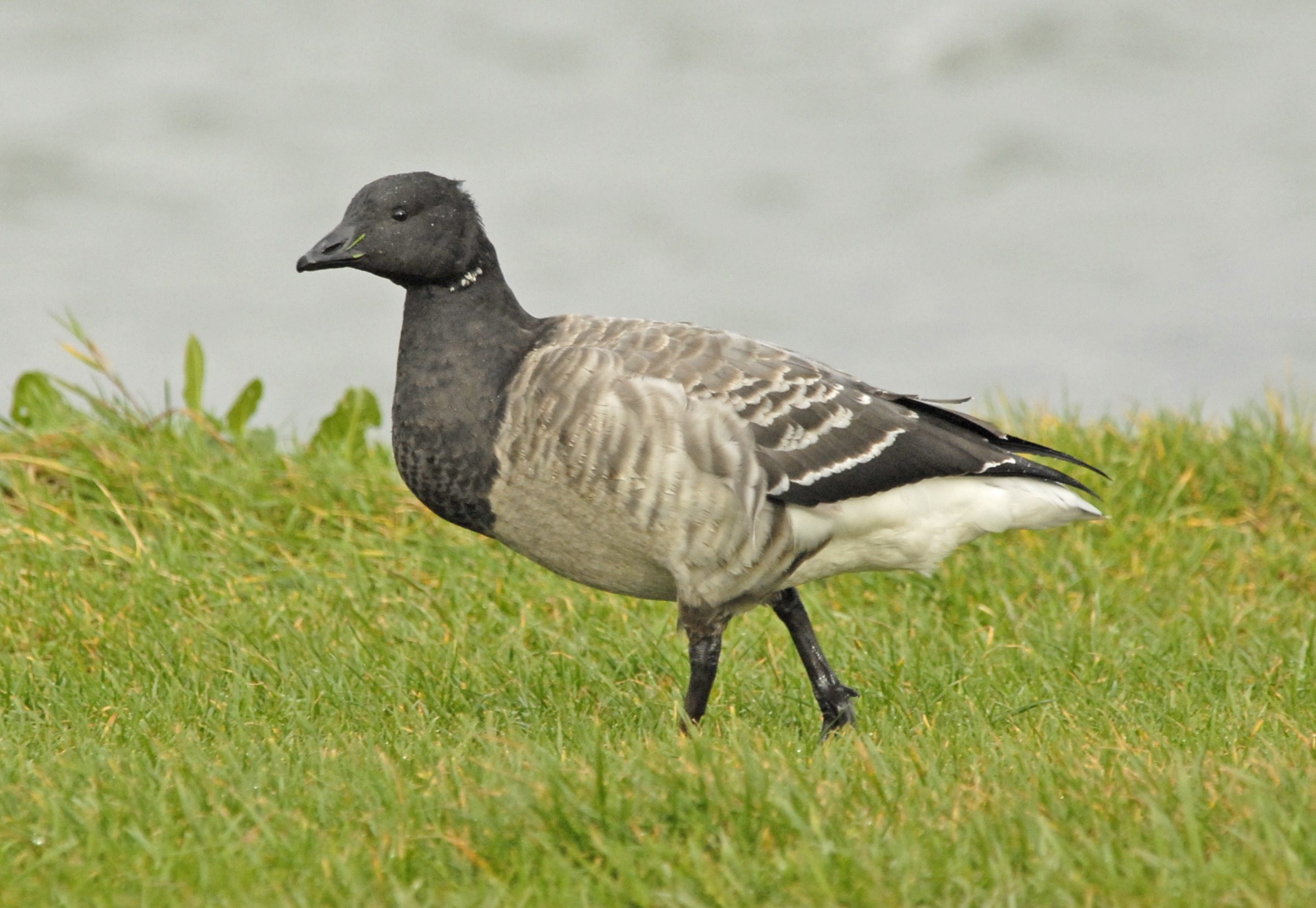
Juvenile Pale-bellied Brent Goose (Dublin, Ireland, 7 December 2006). The lines of bold white tips to the wing coverts clearly identify this bird as a juvenile. Note also the newly emerging but still very small neck collar. The belly is fully juvenile but new adult feathers are appearing in the flanks. The juvenile belly feathers of Pale-bellied and Dark-bellied Brents can be quite pale and very similar, so this bird needs closer examination. Here the new flank feathers appear quite white, strongly indicating Pale-bellied Brent. In a less advanced individual with fully juvenile underparts, the best way to identify it may well be to look at its accompanying parents (Paul Kelly, www.irishbirdimages.com).
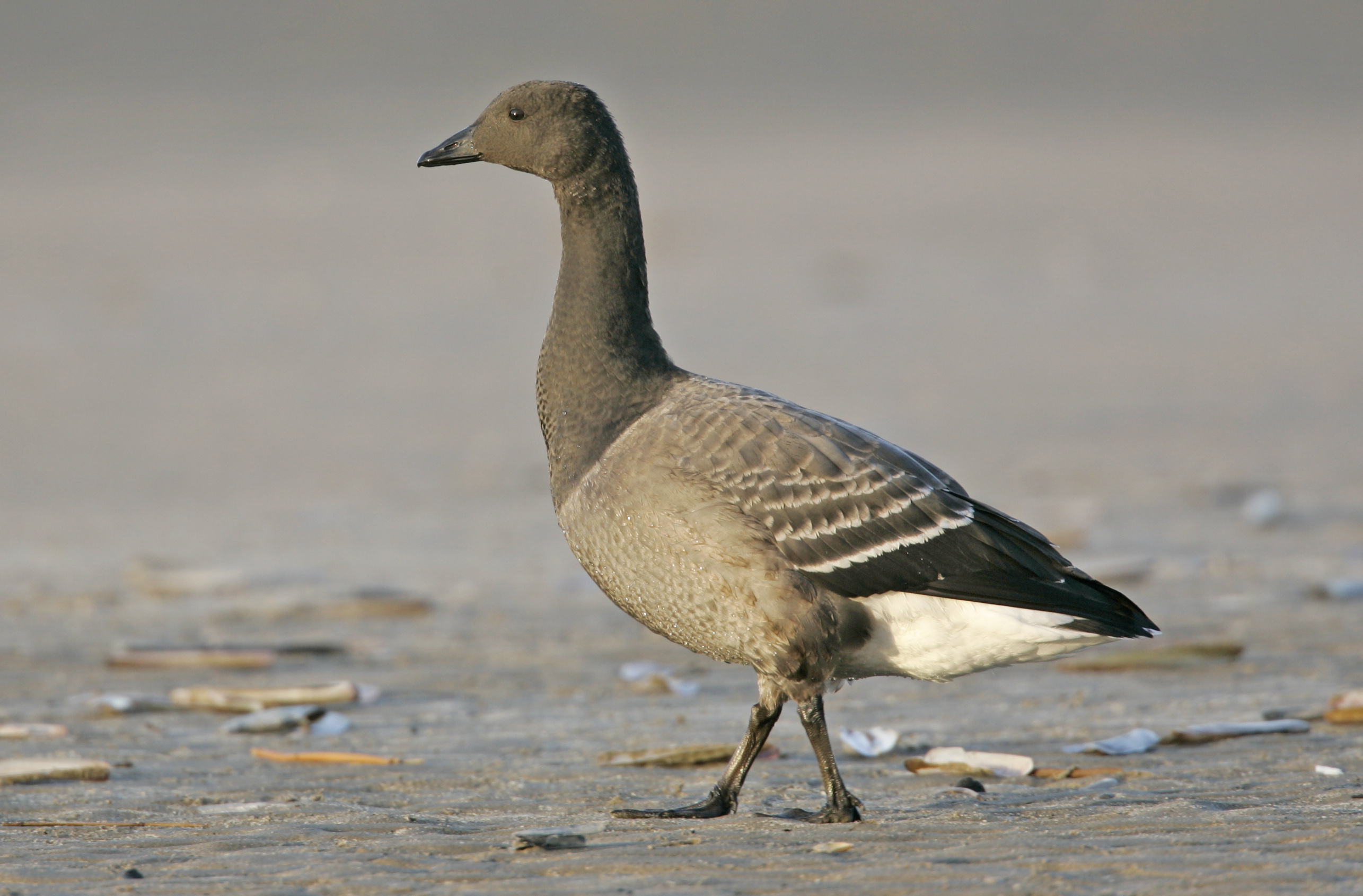
Juvenile Dark-bellied Brent Goose (Katwijk, The Netherlands, 24 November 2007). Photographed in strong sunlight, this juvenile bird (note the white-tipped wing coverts and the complete lack of a neck collar) appears very pale-bellied, but it is not a Pale-bellied Brent Goose. The juvenile underparts of the two subspecies can be very similar, but if in doubt, the best strategy is to work out its identity by reference to its parents (Menno van Duijn, www.agami.nl).
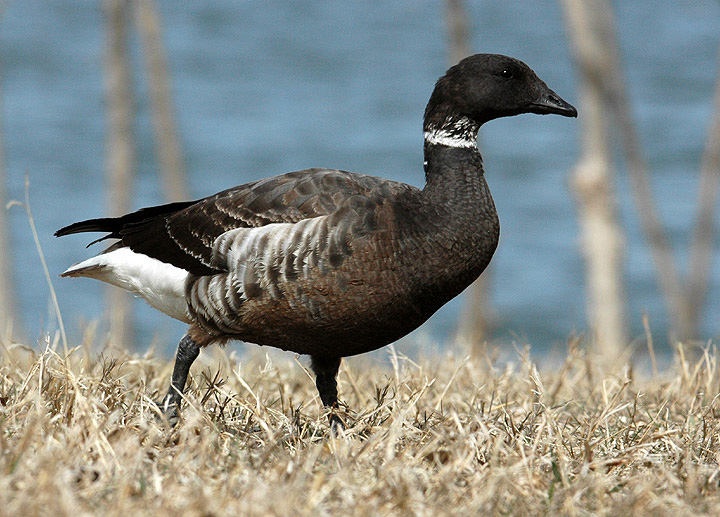
Juvenile Black Brant (Colorado, USA, 19 March 2005). This juvenile Black Brant was photographed in early spring and is much more advanced in its moult into adult plumage than the early winter birds pictured above. The white tips to the wing coverts are narrow and almost worn away, while an obvious adult pattern has emerged on the belly and flanks. The neck collar is also fully developed. These adult features – a bold white flank patch (albeit with dark vertical lining), a bold, deep neck collar and brown hues in the upperparts identify it as a Black Brant. The rusty-brown hues on the underparts of this bird are not typical and seem to be the result of staining (Bill Schmoker).
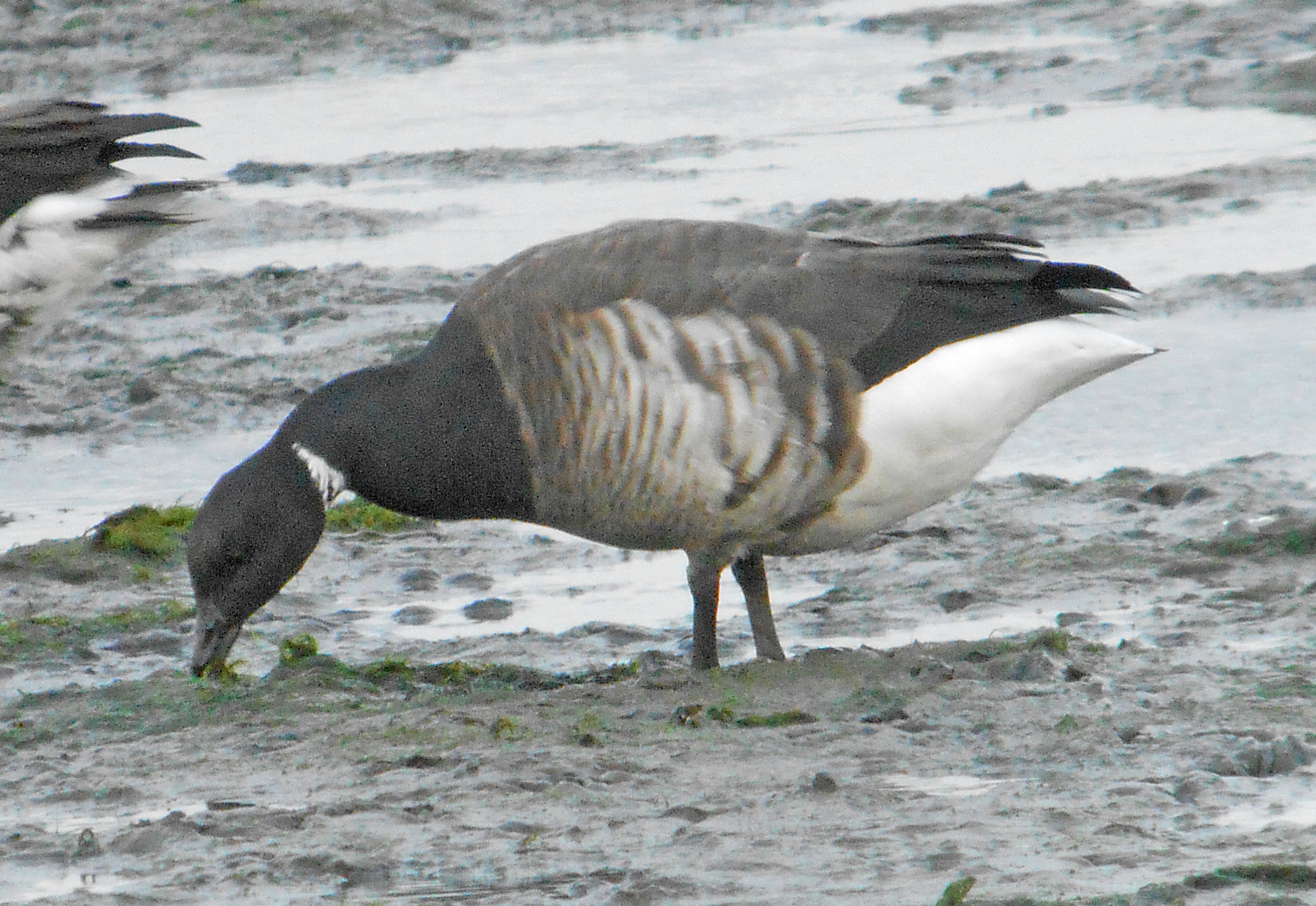
Adult Grey-bellied Brant (Dublin, Ireland, 13 November 2013). This bird shows a confusing mix of brown-toned upperparts and pale belly, but has a strong grey-brown wash across the breast-sides and upper belly and clear dark feathering between the legs, features never shown by Pale-bellied Brent. The neck collar is also conspicuously deep and bold, as in Black Brant. This strange combination of characters is, however, typical of the enigmatic form ‘Grey-bellied Brant’. On its own, this would be a particularly hard bird to identify (most resembling a Dark-bellied x Pale-bellied hybrid), but its Irish location and Canadian Pale-bellied Brent ‘carriers’ give a clear indication that it has a High Arctic Canadian origin (Niall Keogh).
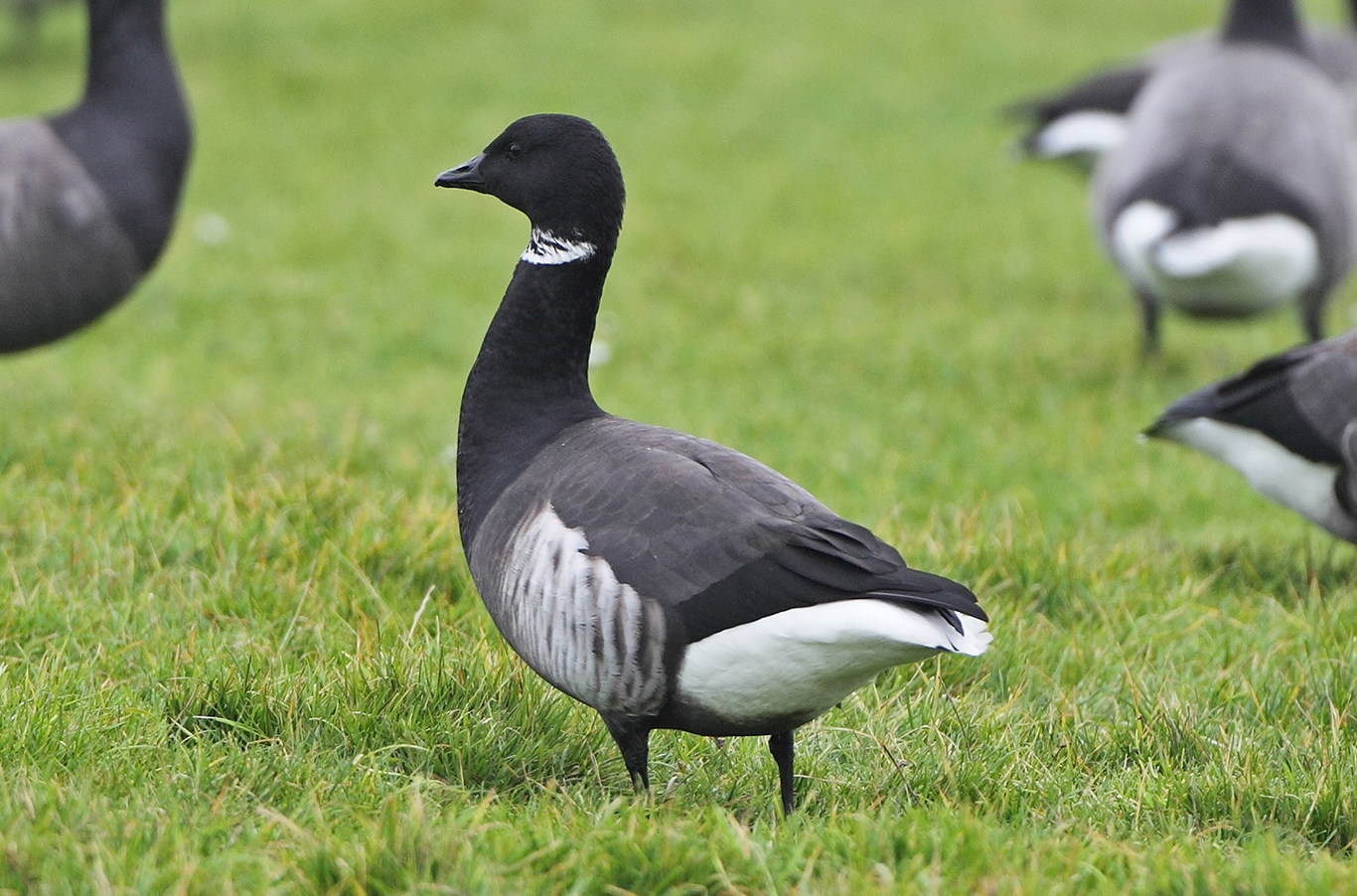
Adult hybrid Black Brant x Dark-bellied Brent Goose (Wells, Norfolk, 22 November 2010). Hybrids occur relatively rarely between Brent Goose subspecies. The most regular combination, with several recorded annually among Dark-bellied Brent Geese in south-east England, is Black Brant x Dark-bellied Brent Goose. Although superficially resembling Black Brant with its large white flank patch and bold, deep collar, the earth-brown hues are completely lacking, replaced by a grey ‘glaze’ to the upperparts and underparts. Hybrids can be subtle, however, shifting in appearance according to the light and closely resembling first one parent form and then the other (Robin Chittenden, www.robinchittenden.co.uk).
- This article was originally published in the February 2017 edition of Birdwatch.






